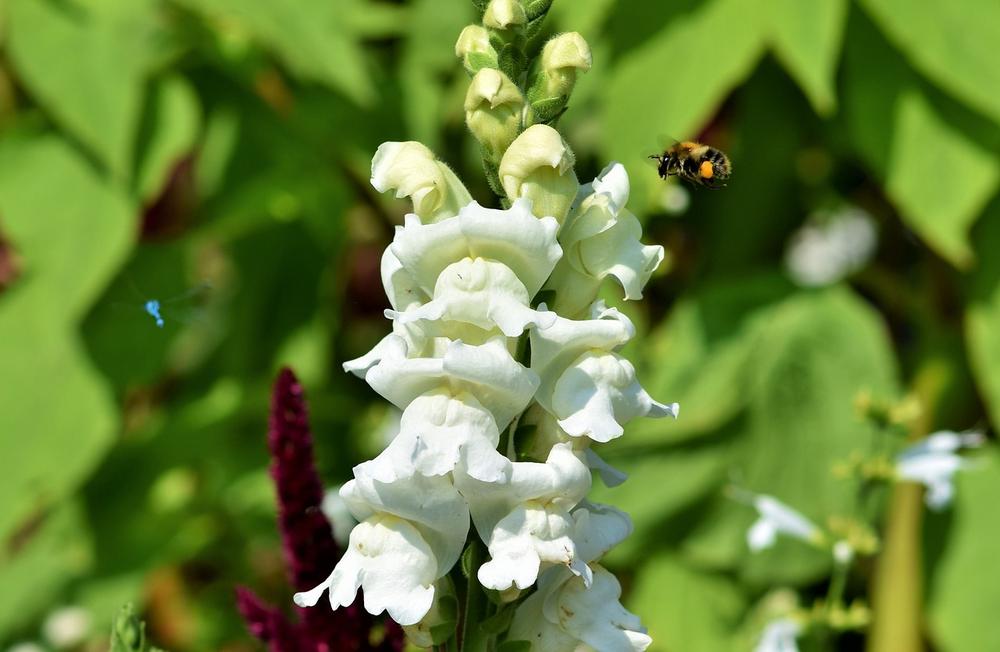Are Snapdragons Poisonous or Toxic to Cats?

Can snapdragons really harm your furry friend?
Feeling anxious about the potential danger to your cat? 😟
I get it.
The last thing you want is for your beloved companion to come to any harm.
So, let's dive in and put your worries to rest, shall we?
Are Snapdragons Poisonous to Cats?

Snapdragons won't harm your cat, but some might have allergies. Here's what you need to know:
- Experts say snapdragons are safe for everyone, including kids and cats.
- Still, watch out for skin issues or breathing troubles if your cat touches them.
- If you suspect poisoning, call your vet pronto.
- You can't always control what your curious kitty finds, so know the signs of trouble.
- Snapdragons themselves won't poison your cat, but be careful with any chemicals on them.
- Make sure those pretty flowers aren't treated with anything that could hurt your fur baby.
In essence, snapdragons can brighten up your garden, but keep watch to keep your cat safe. 😺
Is It Safe for Cats to Eat Snapdragons?
Cats and snapdragons, huh?
Let's dig into the details:
- Snapdragons are generally safe for cats to come into contact with and eat.
- However, if cats accidentally ingest snapdragons while grooming or playing around, they might experience mild gastrointestinal upset.
- To discourage excessive consumption of snapdragons, make sure there are plenty of safe, cat-friendly plants available for grazing.
- Ingesting large amounts of snapdragons can potentially cause an upset stomach and gastrointestinal issues in cats.
- Recovery is usually fast with proper care, so rest assured that your feline friend will bounce back quickly.
- Avoid flower food containing sugar, citric acid, and small amounts of bleach, as these ingredients can cause gastrointestinal problems in cats.
- Excessive consumption of snapdragons should be avoided to prevent upset stomachs.
- Plus, it's good to know that snapdragons do not poison pets and will not harm them if they roll about with, eat, or lick the plant.
Cats may not have a fascination with snapdragons, but a little knowledge goes a long way in keeping them happy and healthy!

I highly recommend learning more about whether it is safe to use baby shampoo on your cat.
In my article, "Can I Use Baby Shampoo on My Cat," I provide important information and insights on this topic.
By understanding the potential risks and benefits, you can make an informed decision regarding the care and grooming of your feline friend.
So, be sure to check out my informative guide for all the details.
What Are Snapdragons?
Snapdragons are unique and vibrant flowers that belong to the Antirrhinum genus. They come in various sizes, shapes, and lively colors, adding energy to any landscape. Native to North America, North Africa, and parts of Europe, snapdragons bloom in vivid shades during spring and fall.
Snapdragons, with their dragon-like appearance, are a one-of-a-kind and vibrant flower.
These remarkable plants belong to the Antirrhinum genus and come in various sizes, shapes, and lively colors.
Native to North America, North Africa, and parts of Europe, snapdragons effortlessly bring energy to any landscape.
Growing up to 4 feet tall, these blossoms bloom in vivid shades throughout the spring and fall seasons.
While snapdragons require annual replanting for continuous flowering, they have a long history of traditional medicinal uses.
Legend has it that these flowers were utilized for treating a range of ailments, including scurvy, liver disorders, tumors, cancer, and ulcers.
However, you must note that individuals with allergies or sensitive skin may experience skin irritation when coming into contact with snapdragons.
Therefore, if you're thinking of incorporating snapdragons into your garden, be mindful of this fact.
Beyond their aesthetic appeal, snapdragons also possess valuable medicinal properties.
They not only serve as captivating centerpieces but can also provide relief due to their healing compounds.
Snapdragons contain substances known to alleviate inflammation and ease pain.
What's more, some research suggests that they may exhibit antimicrobial effects.
However, amidst the enchantment of snapdragons, there arises an important question:
Can cats safely interact with snapdragons?
Well, my friend, while our feline companions are curious creatures, ensuring their safety should always be a priority. Thankfully, snapdragons are considered non-toxic to cats. However, this does not mean we should allow our furry friends to freely consume these plants. Ingesting large quantities of any plant material can still result in stomach upset and digestive issues for cats.
So, although snapdragons can add color and joy to our lives, it's wise to closely monitor our cats' interaction with these flora.
Pay attention to any signs of discomfort or abnormal behavior, and consult a veterinarian if you have any concerns.
Stay tuned for further valuable insights on snapdragons and their impact on our feline companions!
And it gets better...
Not only can snapdragons bring color and joy to your garden, but they can also be planted alongside other safe flowers for cats.
But what other cat-friendly plants should you consider?
Let's explore the world of non-toxic flora that will keep your feline companion happy and healthy in the next section:
Other Cat-Friendly Flowers for the Garden
Include non-toxic flowers in your cat-friendly garden, like snapdragons and celosia.

These vibrant flowers bring bold bursts of color to your garden while being safe for your feline friends. Although some cats may have allergic reactions to snapdragons, they can be planted alongside other cat-safe flowers. You have to prioritize the use of cat-safe fertilizer and avoid harmful chemicals or pesticides in the soil. Indoor cats can enjoy their own plants, such as cat grass, satisfying their natural chewing and digging instincts.
However, steer clear of toxic plants like mint, rhubarb, and foliage from potatoes and tomatoes.
ASPCA provides a list of other harmful plants you should avoid.
How to Keep Cats Away From Snapdragons?
Move the plants or use physical barriers
If you want to keep cats away from snapdragons, a simple solution for you is to move the plants out of their reach.
Cats are curious little creatures, but they can't get to what they can't reach.
Another option that works well for you is creating a physical barrier between your cats and the snapdragons.
You can use a fence or some kind of plant enclosure to keep them away.
Just make sure it's sturdy enough so clever cats won't find a way around it.
Use smell and texture to deter the cats
Cats have sensitive noses, which means they don't like certain smells.
Luckily, there are sprays designed specifically to discourage cats from approaching snapdragons.
You should choose ones that are safe for plants if you want to give them a try. Another natural method that is effective for you is placing citrus peels near the plants. The strong scent of oranges, lemons, or limes really bothers cats and will help keep them away.
Who knew cats hate citrus?
Cover, tape, and distract those cats
Now, cats can be sneaky creatures, so you need to cover all bases to keep them away from snapdragons.
To begin with, covering the soil and containers with aluminum foil creates an uncomfortable surface for cats to walk on, making them less likely to explore. What's more, using double-sided sticky tape on pots is another affordable and efficient way to deter cats.
And here's a fun idea for you:
Provide cats with interactive toys or homemade distractions.
You can give them puzzle toys or even just empty toilet paper rolls.
Not only will this keep cats entertained, but it will also divert their attention away from your beloved snapdragons.
Snapdragons: Safe Choice or Potential Danger?
Key Takeaways:
- Snapdragons (Antirrhinum majus) are non-toxic to cats according to ASPCA and the University of California.
- Contact your veterinarian immediately if you notice symptoms of poisoning.
- Chemical fertilizers or pesticides used on snapdragons do not make the plant toxic to cats.
- Ingesting large amounts of snapdragons may cause an upset stomach in cats, but recovery is usually fast.
- Avoid flower food with sugar, citric acid, and small amounts of bleach, as they can upset cats' stomachs.
- Excessive consumption of snapdragons should be avoided to prevent upset stomachs.
- Snapdragons are attractive, colorful, and safe for cats.
- Snapdragons have a distinct shape resembling a dragon's snout and bloom in vibrant colors.
- They have traditional medicinal uses and can be decorative plants.
- Create a cat-friendly garden by including non-toxic flowers, using cat-safe fertilizer, and avoiding harmful chemicals or pesticides.
- Certain vegetables and plants listed by ASPCA should be avoided due to their toxic nature.
- Take measures to keep cats away from snapdragons, such as moving plants out of reach and using deterrent sprays.
- Covering the soil with foil, using double-sided sticky tape, or providing distraction toys can also deter cats.
And that wraps up today's article.
If you wish to read more of my useful articles, I recommend you check out some of these: Can Cats Drink Green Tea, Is Jasmine Essential Oil Safe for Cats, Pregnant Cat Vomiting, Why Do Cats Rub Their Eyes, and Can a Nursing Cat Get Pregnant
Talk soon,
-Sarah Davis